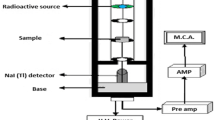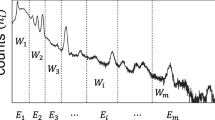Abstract
Mass attenuation coefficients (\(\mu _{\text {m}}\)) for some nonlinear optical materials such as potassium dihydrogen phosphate, ammonium dihydrogen phosphate, zinc tris-thiourea sulphate, and zinc thiourea chloride were measured using a \(2\times 2\) NaI(Tl) scintillation detector at gamma energies of 122 keV, 356 keV, 511 keV, 662 keV, 840 keV, 1170 keV, 1270 keV, and 1330 keV. In addition, GEANT4 simulations were carried out to mimic the experiment at these energies. As a result, good agreement between the experimental and GEANT4 results was observed. The measured \(\mu _{\text {m}}\) values were used to compute effective atomic numbers (\(Z_{\text {eff}}\)) for the selected materials. It was found that the \(Z_{\text {eff}}\) values were in the range typical for dosimetric materials.





Similar content being viewed by others
References
Allison J, Amako K, Apostolakis J, Arce P, Asai M, Aso T, Bagli E, Bagulya A, Banerjee S, Barrand G et al (2016) Recent developments in Geant4. Nucl Instrum Methods Phys Res Sect A Accel Spectrom Detect Assoc Equip 835:186
Awasarmol VV, Gaikwad DK, Raut SD, Pawar PP (2017) Photon interaction study of organic nonlinear optical materials in the energy range 122–1330 keV. Radiat Phys Chem 130:343
Bootjomchai C, Laopaiboon R (2014) Thermoluminescence dosimetric properties and effective atomic numbers of window glass. Nucl Instrum Methods Phys Res Sect B Beam Interact Mater Atoms 323:42
Chantler CT (1995) Theoretical form factor, attenuation, and scattering tabulation for \(\text{ Z }= 1\)–92 from \(\text{ E }= 1\)–10 eV to \(\text{ E }= 0.4\)–1.0 MeV. J Phys Chem Ref Data 24(1):71
Chantler CT (2000) Detailed tabulation of atomic form factors, photoelectric absorption and scattering cross section, and mass attenuation coefficients in the vicinity of absorption edges in the soft X-ray (\(\text{ Z }= 30\)–36, \(\text{ Z }= 60\)–89, \(\text{ E }= 0.1\ \text{ keV }\)–10 keV), addressing convergence issues of earlier work. J Phys Chem Ref Data 29(4):597
Dini D, Calvete MJ, Hanack M (2016) Nonlinear optical materials for the smart filtering of optical radiation. Chem Rev 116(22):13043
Gowda S, Krishnaveni S, Yashoda T, Umesh T, Gowda R (2004) Photon mass attenuation coefficients, effective atomic numbers and electron densities of some thermoluminescent dosimetric compounds. Pramana 63(3):529
Hine G (1951) The effective atomic numbers of materials for various gamma ray processes. Phys Rev 82:725
Hubbell JH, Seltzer SM (1995) Tables of X-ray mass attenuation coefficients and mass energy-absorption coefficients 1 keV to 20 MeV for elements \(\text{ Z }= 1\) to 92 and 48 additional substances of dosimetric interest. Tables of x-ray mass attenuation coefficients and mass energy-absorption coefficients 1 kev to 20 mev for elements \(\text{ z }= 1\) to 92 and 48 additional substances of dosimetric interest. Tech. rep., National Inst. of Standards and Technology-PL, Gaithersburg, MD (United)
Kucuk N, Manohara S, Hanagodimath S, Gerward L (2013) Modeling of gamma ray energy-absorption buildup factors for thermoluminescent dosimetric materials using multilayer perceptron neural network: A comparative study. Radiat Phys Chem 86:10
Kumar TK, Reddy KV (1997) Effective atomic numbers for materials of dosimetric interest. Radiat Phys Chem 50(6):545
Kurudirek M (2014) Effective atomic numbers and electron densities of some human tissues and dosimetric materials for mean energies of various radiation sources relevant to radiotherapy and medical applications. Radiat Phys Chem 102:139
Lin Z, Jiang X, Kang L, Gong P, Luo S, Lee MH (2014) First-principles materials applications and design of nonlinear optical crystals. J Phys D Appl Phys 47(25):253001
Liu X, Guo Q, Qiu J (2017) Emerging low-dimensional materials for nonlinear optics and ultrafast photonics. Adv Mater 29(14):1605886
Manohara S, Hanagodimath S, Gerward L (2009) The effective atomic numbers of some biomolecules calculated by two methods: a comparative study. Med Phys 36(1):137
Manohara S, Hanagodimath S, Gerward L (2010) Energy absorption buildup factors for thermoluminescent dosimetric materials and their tissue equivalence. Radiat Phys Chem 79(5):575
McNair A (1981) ICRU report 33-radiation quantities and units pub: international commission on radiation units and measurements, Washington DC USA issued 15 April 1980, pp. 25. J Label Compd Radiopharm 18(9):1398
Özdemir Y, Kurudirek M (2009) A study of total mass attenuation coefficients, effective atomic numbers and electron densities for various organic and inorganic compounds at 59.54 keV. Ann Nucl Energy 36(11–12):1769
Ramprasath V et al (2000) Effective atomic numbers for photon energy absorption and energy dependence of some thermoluminescent dosimetric compounds. Nucl Instrum Methods Phys Res Sect B Beam Interact Mater Atoms 168(3):294
Shivaramu (2002) Effective atomic numbers for photon energy absorption and photon attenuation of tissues from human organs. Med Dosim 27(1):1
Sidhu BS, Dhaliwal A, Mann K, Kahlon K (2012) Study of mass attenuation coefficients, effective atomic numbers and electron densities for some low Z compounds of dosimetry interest at 59.54 keV incident photon energy. Ann Nucl Energy 42:153
Singh VP, Badiger N (2016) Studies on photon buildup for some thermoluminescent dosimetric compounds. Indian J Phys 90(3):259
Singh VP, Badiger N, Kucuk N (2014) Assessment of methods for estimation of effective atomic numbers of common human organ and tissue substitutes: waxes, plastics and polymers. Radioprotection 49(2):115
Singh VP, Medhat M, Badiger N (2014) Photon attenuation coefficients of thermoluminescent dosimetric materials by Geant4 toolkit, XCOM program and experimental data: a comparison study. Ann Nucl Energy 68:96
Singh VP, Shirmardi S, Medhat M, Badiger N (2015) Determination of mass attenuation coefficient for some polymers using Monte Carlo simulation. Vacuum 119:284
Swinehart D (1962) The Beer–Lambert law. J Chem Educ 39(7):333
Taylor M, Franich R, Trapp J, Johnston P (2008) The effective atomic number of dosimetric gels. Austral Phys Eng Sci Med 31(2):131
Tonguc BT, Arslan H, Al-Buriahi MS (2018) Studies on mass attenuation coefficients, effective atomic numbers and electron densities for some biomolecules. Radiat Phys Chem 153:86
Acknowledgements
The corresponding author would like to express his deep appreciation to Prof. Werner Ruhm, Institute of Radiation Protection, Helmholtz Zentrum München, Neuherberg, Germany for his an excellent corrections and suggestions to improve the present work.
Author information
Authors and Affiliations
Corresponding author
Ethics declarations
Conflict of interest
The authors declare that they have no conflict of interest.
Additional information
Publisher's Note
Springer Nature remains neutral with regard to jurisdictional claims in published maps and institutional affiliations.
Rights and permissions
About this article
Cite this article
Al-Buriahi, M.S., Singh, V.P., Arslan, H. et al. Gamma-ray attenuation properties of some NLO materials: potential use in dosimetry. Radiat Environ Biophys 59, 145–150 (2020). https://doi.org/10.1007/s00411-019-00824-y
Received:
Accepted:
Published:
Issue Date:
DOI: https://doi.org/10.1007/s00411-019-00824-y




